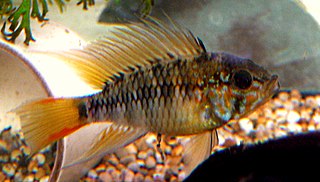
Crenicichla is a genus of cichlids native to South America commonly known as the pike cichlids. They are found in most tropical and subtropical freshwater habitats between the Andes and the Atlantic.

Geophagus is a genus of cichlids that mainly live in South America as far south as Argentina and Uruguay, but a single species, G. crassilabris is from Panama. They are found in a wide range of freshwater habitats. They are part of a group popularly known as eartheaters and mostly feed by picking up mouthfuls of sediment to sift out food items such as invertebrates, plant material and detritus. The largest species reach up to 28 cm (11 in) in standard length. They are mostly kept in aquariums.

Sven Oscar Kullander is a Swedish biologist specialised in ichthyology. He primarily researches cichlids – notably the genus Apistogramma and the Cichlasoma-complex – and other tropical fresh water fishes. He also has been working with endangered fish species in Sweden.
Apistogramma regani is a species of South American dwarf cichlid. It is a freshwater fish found in the lower Rio Negro basin in the Amazon. The specific name is in honour of the British ichthyologist Charles Tate Regan.

Apistogramma macmasteri is a dwarf cichlid in the tribe Geophagini, one of the tribes of the subfamily of American cichlids, the Cichlinae. It is a freshwater fish that lives in the rivers Guaytiquía and Metica in the Meta River system. The Meta river system is a part of the Orinoco basin in Colombia. They live in areas with soft sandy bottom and plenty of dead roots and branches in the water. Plants are uncommon in areas where Apistogramma macmasteri is found.
Crenicichla geayi, also known as the half-banded pike cichlid, is a species of cichlid native to South America. It is found in the Orinoco River basin and in the Portuguesa River basin. This species reaches a length of 18.4 cm (7.2 in).
Wallaciia heckeli is a species of cichlid native to South America. It is found in the Amazon River basin and in the Trombetas River close to Cachoeira Porteira, Brazil. This species reaches a length of 5.2 cm (2.0 in).
Crenicichla isbrueckeri is a species of cichlid native to South America. It is found in the Amazon River basin and in the Aripuanã River basin. This species reaches a length of 9.5 cm (3.7 in).
Crenicichla pellegrini is a species of cichlid native to South America. It is found in the Amazon River basin and in the Aripuanã River basin. This species reaches a length of 15.7 cm (6.2 in).

Wallaciia regani is a species of cichlid native to South America. It is found in the Amazon River basin and in the Trombetas River at Cachoeira Porteira, Brazil. This species reaches a length of 7.9 cm (3.1 in).
Crenicichla santosi is a species of cichlid native to South America. It is found in the Amazon River basin and in the Machado River of Rondônia, Brazil. This species reaches a length of 12 cm (4.7 in).
Crenicichla stocki is a species of cichlid native to South America. It is found in the Amazon River basin and in the Tocantins River basin. This species reaches a length of 25 cm (9.8 in).
Crenicichla sveni is a species of cichlid native to South America. It is found in the Orinoco River basin, in the Llanos of Venezuela and Colombia.. This species reaches a length of 25 cm (9.8 in).

Crenicichla gillmorlisi is a species of cichlid native to South America. It is found in the Río Acaray drainage in Paraguay. This species reaches a length of 17.4 cm (6.9 in).
Crenicichla mandelburgeri is a species of cichlid native to South America. It is found in the río Paraná basin. This species reaches a length of 20.8 cm (8.2 in).
Crenicichla rosemariae is a species of cichlid native to South America. It is found in the upper Xingu River drainage; Suiá-Missu River, Amazon River basin in Brazil. This species reaches a length of 24.4 cm (9.6 in).
Crenicichla monicae is a species of cichlid native to South America. It is found in the lower Rio Uaupés and lower Rio Içana, tributaries of the upper Rio Negro in Brazil. This species reaches a length of 27.3 cm (10.7 in).

Crenicichla wallacii is a species of cichlid native to South America. It is found in the Essequibo River basin, Guyana. This species reaches a length of 8.5 cm (3.3 in).

Crenicichla haroldoi is a species of cichlid native to South America. It is found swimming in the upper Paraná River basin, Brazil. This species reaches a length of 9.8 cm (3.9 in).
Crenicichla ploegi is a species of cichlid native to South America. It is found swimming in Brazil. This species reaches a length of 28 cm (11 in).









